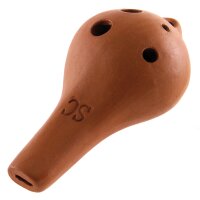Ocarinas
Because of its shape the name of this vessel flute derives from the Italian term oca (goose) and means as much as “little goose”. Ocarinas were already played more than 12.000 years ago in South America, Africa and also in China. At the hands of Spanish sailors some of those instruments from South America arrived in Europe. In the mid-19th-century the today wide-spread European version emerged: the concert ocarina. It has got ten tone holes and a pitch range of one and a half octaves.
The ocarinas available at DAN MOI are made of ceramic. Their corpus has got a simple blowing mechanism and several tone holes which can alter the pitch by covering and opening them. DAN MOI offers instruments by two different producers. Both provide an enormous variety of shapes and neatly tuned instruments. The 4-hole ocarinas are best suited for early musical education. They have the shapes of animals and can easily be played without knowing the keys. The 6-hole ocarina, also known as Inca-ocarina, has four holes on the upper side and two at the bottom. Advanced musicians get their money’s worth with the 10-hole ocarina – it is fully chromatic.











